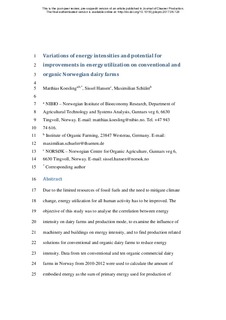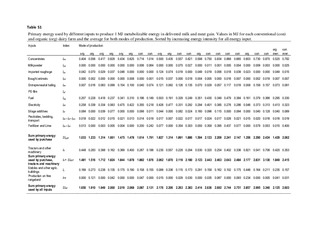| dc.contributor.author | Koesling, Matthias | |
| dc.contributor.author | Hansen, Sissel | |
| dc.contributor.author | Schueler, Maximilian | |
| dc.date.accessioned | 2018-03-14T10:10:22Z | |
| dc.date.available | 2018-03-14T10:10:22Z | |
| dc.date.created | 2017-12-17T20:18:46Z | |
| dc.date.issued | 2017-06-17 | |
| dc.identifier.citation | Journal of Cleaner Production. 2017, 164 301-314. | nb_NO |
| dc.identifier.issn | 0959-6526 | |
| dc.identifier.uri | http://hdl.handle.net/11250/2490423 | |
| dc.description.abstract | abstract Due to the limited resources of fossil fuels and the need to mitigate climate change, energy utilisation for all human activity has to be improved. The objective of this study was to analyse the correlation between energy intensity on dairy farms and production mode, to examine the influence of machinery and buildings on energy intensity, and to find production related solutions for conventional and organic dairy farms to reduce energy intensity. Data from ten conventional and ten organic commercial dairy farms in Norway from 2010 to 2012 were used to calculate the amount of embodied energy as the sum of primary energy used for production of inputs from cradle-to-farm gates using a life cycle assessment (LCA) approach. Energy intensities of dairy farms were used to show the amount of embodied energy needed to produce the inputs per metabolizable energy in the output. Energy intensities allow to easily point out the contribution of different inputs. The results showed that organic farms produced milk and meat with lower energy intensities on average than the conventional ones. On conventional farms, the energy intensity on all inputs was 2.6 ± 0.4 (MJMJ?1) and on organic farms it was significantly lower at 2.1 ± 0.3 (MJ MJ?1). On conventional farms, machinery and buildings contributed 18% ± 4%, on organic farms 29% ± 4% to the overall energy use. The high relative contribution of machinery and buildings to the overall energy consumption underlines the importance of considering them when developing solutions to reduce energy consumption in dairy production. For conventional and organic dairy farms, different strategies are recommend to reduce the energy intensity on all inputs. Conventional farms can reduce energy intensity by reducing the tractor weight and on most of them, it should be possible to reduce the use of nitrogen fertilisers without reducing yields. On organic dairy farms, energy intensity can be reduced by reducing embodied energy in barns and increasing yields. The embodied energy in existing barns can be reduced by a higher milk production per cow and by a longer use of the barns than the estimated lifetime. In the long run, new barns should be built with a lower amount of embodied energy. The high variation of energy intensity on all inputs from 1.6 to 3.3 (MJ MJ?1) (corresponding to the energy use of 4.5e9.3 MJ kg-1 milk) found on the 20 farms shows a potential for producing milk and meat with lower energy intensity on many farms. Based on the results, separate recommendations were provided for conventional and organic farms for reducing energy intensity. | nb_NO |
| dc.language.iso | eng | nb_NO |
| dc.publisher | Elsevier | nb_NO |
| dc.rights | Attribution-NonCommercial-NoDerivatives 4.0 Internasjonal | * |
| dc.rights.uri | http://creativecommons.org/licenses/by-nc-nd/4.0/deed.no | * |
| dc.subject | Økologisk landbruk | nb_NO |
| dc.subject | Organic farming | nb_NO |
| dc.subject | Bærekraftige energisystemer | nb_NO |
| dc.subject | Sustainable energy systems | nb_NO |
| dc.subject | Melkeproduksjon | nb_NO |
| dc.subject | Dairy production | nb_NO |
| dc.subject | Energiutnyttelse | nb_NO |
| dc.subject | Energy utilization | nb_NO |
| dc.title | Variations of energy intensities and potential for improvements in energy utilisation on conventional and organic Norwegian dairy farms | nb_NO |
| dc.type | Journal article | nb_NO |
| dc.type | Peer reviewed | nb_NO |
| dc.description.version | acceptedVersion | nb_NO |
| dc.rights.holder | © 2017 Elsevier Ltd. All rights reserved. | nb_NO |
| dc.subject.nsi | VDP::Landbruksfag: 910 | nb_NO |
| dc.subject.nsi | VDP::Agricultural sciences: 910 | nb_NO |
| dc.source.pagenumber | 301-314 | nb_NO |
| dc.source.volume | 164 | nb_NO |
| dc.source.journal | Journal of Cleaner Production | nb_NO |
| dc.identifier.doi | 10.1016/j.jclepro.2017.06.124 | |
| dc.identifier.cristin | 1528558 | |
| dc.relation.project | Norges forskningsråd: 199487 | nb_NO |
| dc.relation.project | Andre: Møre og Romsdal Fylke | nb_NO |
| cristin.ispublished | true | |
| cristin.fulltext | postprint | |
| cristin.qualitycode | 2 | |


